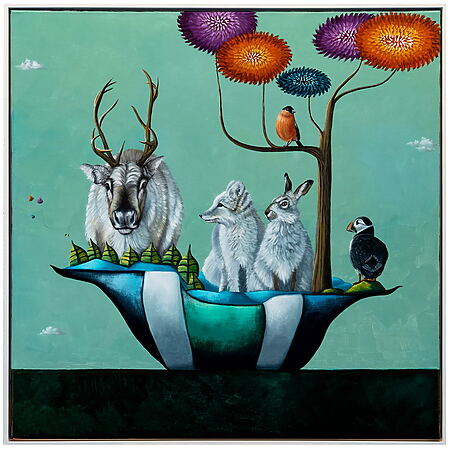In the modern world of work, the office environment is becoming increasingly important for creativity and productivity. For artists and art enthusiasts, the design of offices and workplaces offers an exciting way to create environments that are not only functional, but also inspiring. This article offers an overview of how artistic influences and innovative design can shape the offices of the future.
Art in the work room
Art in the workplace is more than just decoration; It can be a source of inspiration and a means of promoting creative thinking.
Studies show that works of art in the office improve working morals, reduce stress and increase general satisfaction at work .
For the office of the future, this means that art is viewed an integral part of the work environment
Elements of artistic inspiration:
- Colors and shapes : lively colors and interesting shapes stimulate creativity.
- Changing exhibitions : Regularly changing works of art keep the surroundings dynamically and mentally stimulating.
- Interactive art installations : These can encourage employees to do creatively and at the same time take a break from everyday digital life.
Ergonomics and design
The health at work is another essential aspect in the design of modern offices.
Ergonomically designed furniture plays a crucial role, since they directly influence comfort and well -being at work. An ergonomic office chair, for example, not only supports healthy posture, but can also increase productivity by minimizing symptoms caused by long sitting.
Design and aesthetics of office furniture
Modern office facilities are designed in such a way that they are both functionally and stylistically appealing to create an inspiring office ambience.

Photo by Danielle Cerullo @dncerullo, via Unsplash
Technology and flexibility
The integration of technology into office design plays a key role for the offices of the future.
Intelligent office solutions , such as height -adjustable desks and networked office furniture that provide data for use and ergonomics, are becoming increasingly important.
These technologies enable a flexible working environment that adapts to the needs of the users and at the same time creative and efficient work .
Smart Office Tools as a technological innovation
Smart Office Tools revolutionize the world of work through the automation of routine tasks and the improvement of the workplace environment.
These intelligent systems use sensors and software to control everything from lighting and temperature to security systems and conference room reservations.
By collecting and analyzing data on space use and employee presence, Smart Office Tools enable more efficient use of resources and at the same time improve the well -being of employees.
For example, lighting and air conditioning systems can be automatically adjusted to save energy and at the same time create optimal working conditions.
In addition, they promote collaboration through tools such as digital whiteboards or meeting room management systems that can be seamlessly integrated into the daily processes and thus create a more productive and inspiring working environment.
Sustainability in focus
Sustainability is becoming increasingly important in the design of modern jobs.
Materials that are environmentally friendly and recyclable, as well as energy efficiency in office buildings, are not only good for the environment, but also for the well -being of the employees.
Offices in which environmental awareness is lived can also serve as a source of inspiration for creative people who value ecological sustainability.
Sustainable practices in office design:
- Recycled materials : Use of ecologically responsible materials in furniture production.
- Energy-efficient technologies : use of LED lighting and energy-efficient devices.
- Green rooms : integration of plants and green areas to improve air quality and indoor climate.
Future trends in office design
New technologies and a profound understanding of human needs are driving innovative trends in the office design of the future . They not only change the way we work, but also how we feel in our work environments.
Two particularly forward -looking trends are the use of augmented reality (AR) and modular office furniture.
Augmented Reality (AR)
Augmented reality offers revolutionary opportunities in the design of jobs.
With AR, designers and users can visualize and adapt office environments in real time before physical changes are made.
This enables flexible interior design that is specifically tailored to the needs and preferences of employees.
AR can also be used to virtual works of art in offices that promote creativity and inspiration.
Modular office furniture
Modular office furniture is designed in such a way that they are flexible, expandable and fully adjustable. These furniture can be quickly changed, expanded or reduced to react to changes in team size or working methods.
The key lies in the flexibility and scalability that enables companies to use their physical rooms efficiently and effectively:
- Adaptable work stations : Modular units that make it possible for individual jobs to change easily from sitting or be converted into collaborative clusters.
- Sustainability and reusability : Modular systems promote sustainability by offering long life cycles and the opportunity to replace individual components instead of replacing complete facilities.
Conclusion
The offices of the future are more than just jobs; They are spaces of inspiration , well -being and creativity . By combining art, ergonomics, technology and sustainability, such work environments can become sources of inspiration and efficiency.
It is important to create spaces where daily work becomes an inspiring experience.

Owner and managing director of Kunstplaza. Publicist, editor and passionate blogger in the field of art, design and creativity since 2011. Successful conclusion in web design as part of a university degree (2008). Further development of creativity techniques through courses in free drawing, expression painting and theatre/acting. Profound knowledge of the art market through many years of journalistic research and numerous collaborations with actors/institutions from art and culture.



















